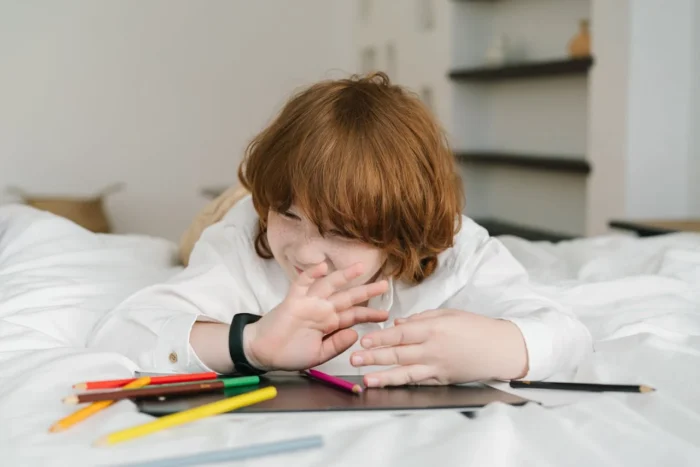
For most parents with a child on the autism spectrum, starting ABA therapy feels like grabbing a lifeline. It teaches children skills that seem to unlock a whole new world for them. But, as with all good things that take time, you begin to wonder how long they’ll be needed.
There is no clear-cut answer, as some kids might be ready to spread their wings sooner, while others benefit from a bit more time.
Here, we’ll talk about moments that indicate when to stop ABA therapy and what to do next, as well as when it’s a good idea to keep going.
How Long Does ABA Therapy Last?
Just as every kid is unique, so too is their journey through ABA therapy. Although the duration of therapy varies from child to child, it typically lasts three to five years and is determined by a child’s individual development and goals.
On average, a child may spend two or three years in comprehensive ABA therapy before moving on to more focused therapy for a few years.
The first step in a therapy plan is to receive a therapist’s evaluation. You should be aware that an early start, ideally when children are aged two to six, can set a strong foundation and have a significant impact on the length of therapy, which is essential for realizing developmental potential.
That said, ABA therapy age limit does not really exist as the therapy is effective later in life, too. For this reason, even adults can benefit from ABA therapy.
ABA Therapy Success & Long-Term Impact
Research shows that ABA therapy significantly improves social skills and life for children with autism, with benefits that last long after sessions end. Studies highlight that starting ABA early is beneficial for the child, leading to better communication, social interactions, and independence.
You’re likely to hear positive as well as negative comments about the ABA method, but many parents report long-term improvements.
How Long Are ABA Therapy Sessions for Kids?
In terms of weekly commitment, most children dedicate 10 to 30 hours each week to therapy, though those in more intensive programs may attend 30 to 40 ABA therapy hours per week.
Sessions last anywhere from two to seven hours, depending on the needs and abilities of the child, as well as the severity of the symptoms.
As the kid progresses in therapy, the number of hours they need can decrease, but they can also be increased if necessary.
At some point, you may wonder: is 6 hours of ABA therapy enough? Admittedly, it could work well for someone, but there is no universal answer due to the fact that no child with autism is exactly the same. Determining the right length of ABA therapy is impossible without proper assessment. Therefore, always choose to hear professional input before making any commitments.
Identifying the Right Time to Transition Away from ABA
While ABA therapy has great advantages for children on the autism spectrum, the path through ABA therapy isn’t meant to stretch out forever. Recognizing when it’s time to dial down or fully step away from ABA therapy requires closely monitoring your child’s growth and progress both by parents and professionals.
Here are some ABA discharge criteria examples that mean it might be time to consider a change in therapy plan:
- Your child’s key therapy goals, like improved communication and social skills, have been successfully met.
- Issues that once seemed insurmountable, such as tantrums or aggression, now occur less frequently or are more manageable.
- Your kid has mastered basic everyday skills and established a solid behavioral and skill base.
- Despite ongoing therapy, your child’s development has plateaued and certain symptoms persist for an extended period of time.
- Other therapies may now be a better fit as your child enters new growth stages.
These indicators can guide your decision to adjust or end ABA therapy.
Additionally, checking in with your child’s Board Certified Behavior Analyst (BCBA) on a regular basis can ensure that any changes in therapy are deliberate steps toward what is truly best for your child.
Is It Better to Simply Stop ABA Therapy, or Reduce It Gradually?
The question of how to stop ABA therapy is also an important one. Choosing to gradually reduce ABA therapy sessions rather than abruptly discontinuing them is the most beneficial path — unless the therapy itself triggers the child.
This gradual approach is like slowly easing into colder waters, allowing the child to retain the strides they’ve made while minimizing the chances of regression. It’s a delicate process in which each reduction in therapy hours is thoughtfully considered, and the child and their family can adjust at their own pace.
This strategy preserves the child’s achievements, but also nurtures the partnership between families and therapists. Together, they reflect on the journey made and plan thoughtfully for the road ahead.
For some families, transitioning to a consultation model may be the next step because it offers support that still keeps the door open for reintroducing more intensive therapy if the need arises.
Life After ABA Therapy
Once ABA therapy wraps up, it’s a new chapter for your family to support your kid’s independence and progress. Putting into practice what they’ve learned during therapy becomes part of everyday life.
In the first few months after therapy ends, keep a close eye on how your child is doing. Adjustments might be needed, and it’s okay to consider revisiting ABA therapy if you face new challenges or see signs of regression.
If it helps, look into additional supports like speech, physical, or occupational therapy, which can build on the progress made. You can also look into school-based support to help with the transition process.
To keep your child engaged, plan enjoyable ABA activities at home that promote social interaction, such as art classes, sports, or simple playdates. Don’t forget that you have the community around you and the support network you’ve built at home to rely on.
When Should You Continue with ABA Therapy?
Recognizing when to go on with ABA therapy is just as important as knowing when to stop. For example, if your 6-year-old with autism is still working towards important skills like self-care or making friends, it usually means ABA remains necessary.
Additionally, challenges with daily routines or struggling when adapting to new changes signal that your child could benefit from more support through therapy.
Another clear indicator is when your child struggles to apply learned concepts outside of therapy, like at home or in school. While there is no one-size-fits-all answer when it comes to how many hours of ABA therapy is needed, practice makes perfect—and there’s nothing wrong with needing a bit more practice.
Lastly, communicating with your child’s BCBA consistently allows you to hear expert opinions and make informed decisions that benefit your child’s ongoing development.
Wrapping Up
Stopping ABA therapy is a big decision that should be based on your child’s personal achievements and readiness. At Abacus Therapies, we understand the weight of this moment and stand ready to offer our support and expertise as you guide your child into this new chapter.
FAQs
How long should a child be in ABA therapy?
It depends on the severity and persistence of a child’s symptoms, as well as the environment and collaboration between parents, other family members, teachers, and therapists. From a few months to a few years, the answers about how long ABA therapy for autism should be applied vary greatly as they are highly individual.
What happens if you stop ABA therapy?
Stopping ABA therapy before the time is right may result in a plateau or regression of the child’s skills and behaviors. That is why it’s important to continue practicing the strategies at home and seek additional help when needed.
When do you discharge from ABA?
Discharge from ABA therapy occurs when a child has met their therapy goals, demonstrates consistent behaviors across environments, or no longer benefits from the therapy as determined by regular assessments.
When is ABA therapy not effective?
ABA therapy may be considered ineffective if:
- There is no progress despite ongoing efforts
- The therapy plan fails to meet the child’s specific needs
- There’s insufficient cooperation between the family and the therapist
- The child shows significant distress or aversion to therapy sessions.



